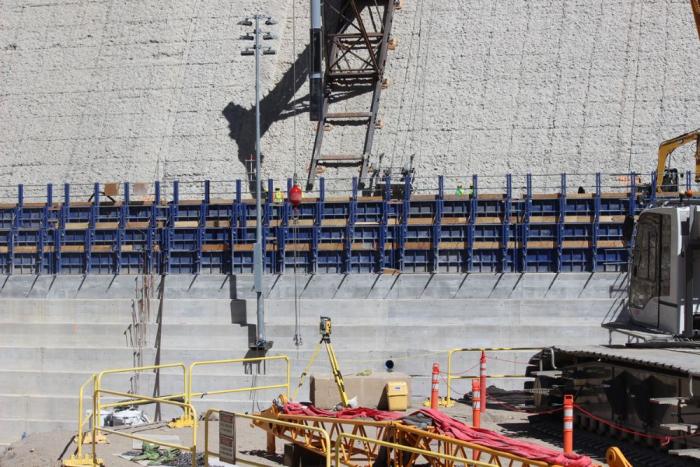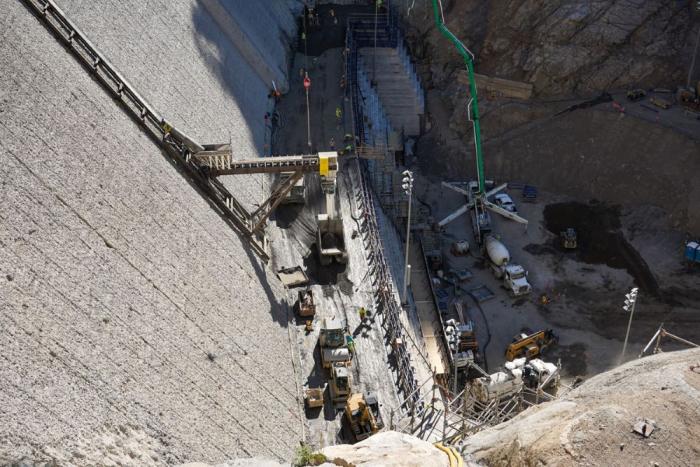Step by step, Gross Dam is going up
The new look of Denver Water’s Gross Dam is starting to take shape.
Workers began placing new concrete at the base of the Boulder County dam in early May, and by mid-July, they had constructed the first 100 feet of the new steps that will raise the height of the dam.
The Gross Reservoir Expansion Project will raise the height of the dam by 131 feet for a total new height of 471 feet.
In raising the dam, workers are also making it wider and thicker.
The new, higher dam will nearly triple the storage capacity of Gross Reservoir, which will help add balance and resiliency to Denver Water’s overall water storage system.
“It’s an exciting time for our team here at Gross Reservoir,” said Doug Raitt, Denver Water’s construction manager for the project. “We spent two years preparing the foundation for the new addition, and now we’re building the new structure.”
Learn more about the Gross Reservoir Expansion Project.
Raising the dam involves building 118 steps on the downstream side of the dam.
While the old dam had a flat surface, the front of the expanded one will look more like the ancient pyramids of Egypt.
The process involves placing roller-compacted concrete, a type of concrete named after how it’s applied.
The work begins by building forms to hold the concrete in place. Then a truck on tank-like tracks dumps the concrete inside the formwork. A bulldozer then spreads the concrete, followed by a machine with a large vibrating roller that compacts and smooths the concrete.
Each step is 4 feet tall with a 2-foot setback.
“The big benefit of the roller-compacted concrete process is the speed at which we can place it,” Raitt said. “The concrete is firm enough for the trucks to drive on it right away, so we can continue working on the dam without having to wait for it to firm up and cure.”
The photo above shows a variety of construction elements.
On the upper left of the picture is the drop chute where roller-compacted concrete comes down from the top. The concrete falls into a dump truck seen in the middle of the picture.
The new steps can be seen below the dump truck. A concrete pumping machine with the green boom is used to deliver traditional concrete for the exterior surface of the new dam.
The concrete is all being produced on-site with rock quarried from the south side of the reservoir. An elaborate system consisting of a tower and several conveyors was built to transport the concrete from the batch plant down to the bottom of the dam.
The face of the dam was roughened to create a better bond with the new concrete. Grout also is used to fill in any small crevices and acts like glue to ensure a strong bond.
Workers place an additional layer of traditional concrete on the outside edge of the new steps. The extra concrete acts as a protective layer that will help the new, higher dam withstand the elements.
“Having the batch plant on-site helps ensure that we have the quality of concrete that we want and makes for an efficient delivery system,” Raitt said. “We’re working 24 hours a day, seven days a week into the fall to take advantage of the weather and keep the project on schedule.”
Raitt said the goal for 2024 construction season is to build the new steps to a point just below the top of the existing dam. In 2025, workers will continue building the additional 131 feet.
The entire project is set to wrap up in 2027.
“We have about 250 people on-site from our contractor Kiewit Barnard doing a great job of working through all the challenges that come up during the project,” Raitt said.
“Everyone takes a lot of pride in their work knowing this is an important part of supplying water to our Denver Water customers in the future.”






